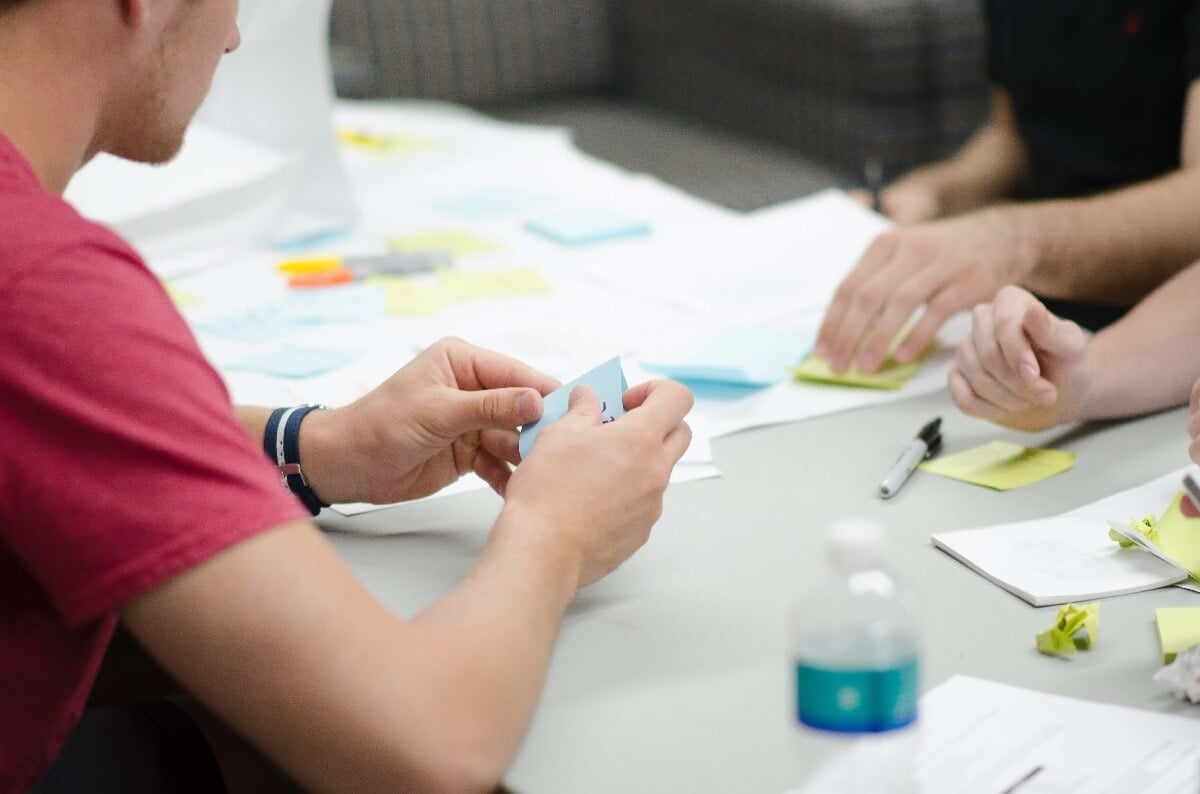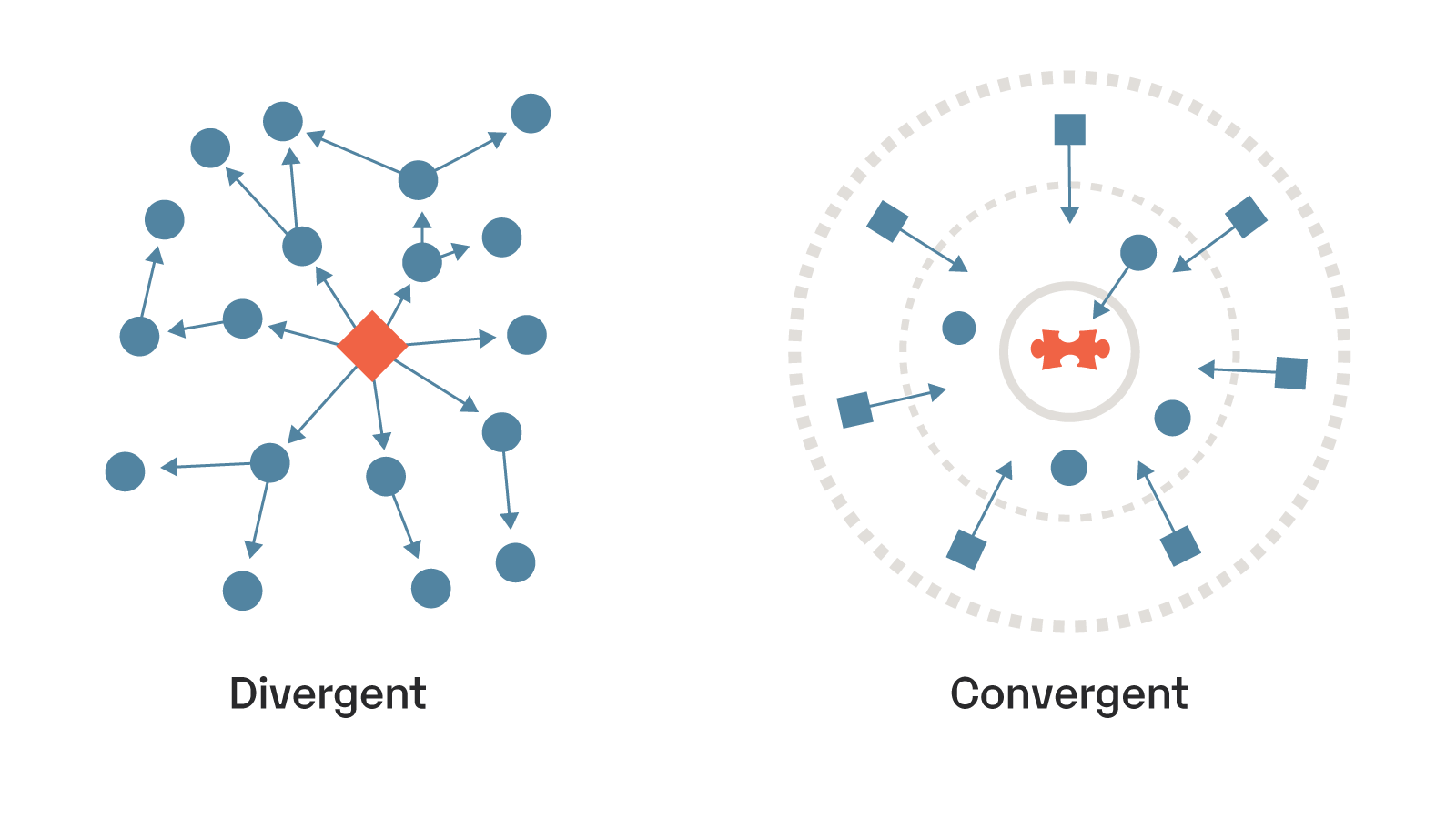Structured Ideation: Tips for Better Creative Brainstorming
Dennis Kardys Head of Design & Development#Industry Insights, #Design, #News & Culture

How do you get the best ideas from your team? Through creative brainstorming. By understanding the value of structured ideation, you can use your brainstorming sessions to unlock the creativity of your team.
You’re kicking off a new project and the possibilities seem endless. Whatever you decide to do or make is going to take an investment of time and effort from a whole team of people. Choosing the best course of action can be a lot of pressure. So how do you get the best ideas from your team so that you feel confident moving forward? Brainstorming is a common go-to for many teams, but every time I hear the word mentioned I cringe.
The Problem with Brainstorming
The problem I have with brainstorming is that it’s genericized. The term is thrown around loosely and depending on the facilitator can refer to anything from a casual conversation to a full-day collaborative workshop. Meeting invites pop-up with the noble intent to harness creativity and introduce diverse perspectives. And when a session is run well, that can be the result. But when structure, purpose and an understanding of social dynamics is absent, brainstorming sessions can quickly degenerate into meandering pontification and design by committee.
Do Brainstorming Sessions Work?
Surprisingly, research has shown that group brainstorming can stifle creativity. Many of the familiar brainstorming techniques still practiced today originate from a book written by advertising exec Alex Osborn in the 1940s. Research conducted at Yale in the late 50s (and validated in follow-up studies) has since debunked the effectiveness of many of his theories by showing that individuals regularly outperform groups in creative problem-solving and idea generation. If the goal is to come up with the best ideas, why bother with brainstorming at all?
Improving Your Ideation Process
Not all brainstorming is ineffective. While there is evidence citing that traditional brainstorming methods (as taught by Osborn) are flawed, research also shows that when faced with complex problems, teamwork and collaboration can lead to better, more feasible solutions. If you want to unlock the creative ideas of your team, you just need to consider a few things.
Avoid one-dimensional teams. Assemble a diverse group.
When self-organizing into groups, people tend to feel more comfortable around people who look and think like they do. This bias can unintentionally affect our behavior and result in one-dimensional teams. These like-minded groups are more likely to draw similar conclusions and arrive at similar solutions. Evidence shows that diverse teams regularly outperform one-dimensional groups at solving problems that demand outside of the box thinking.
When assembling a group, think about multiple ways you can introduce diversity. Diversity can be inherent—traits people are born with, such as gender, ethnicity and sexual orientation. Diversity can also be acquired—this includes diversity of knowledge, expertise, and experience. And cognitive diversity describes the differing ways individuals process information, make decisions, and come up with creative solutions.
Teams that can bring a spectrum of perspectives to the table will not only come up with a wider range of ideas, they are also more likely to challenge one another’s biases and assumptions.
Avoid groupthink. Prioritize action over discussion.
Without solid structure and facilitation, groups may try to steer your brainstorming session toward a more familiar and comfortable meeting format—discussion. But getting a bunch of people into a room to talk about ideas is not enough. Even if all team members contribute to the conversation, ideas coming from the most outspoken or charismatic people can gain the most traction. And when a HiPPO (highest paid person’s opinion) is in the room, those with less clout or a smaller voice may see their ideas get brushed aside.
Group discussions can also breed poor decisions. The intended outcome of most meetings is to arrive at a consensus or a decision. This can trigger a psychological phenomenon called groupthink.
“Groupthink occurs when a group of well-intentioned people make irrational or non-optimal decisions spurred by the urge to conform or the discouragement of dissent. This problematic or premature consensus may be fueled by a particular agenda, or simply because group members value harmony and coherence above rational thinking.”
In Design Thinking, there is a core principle called “bias toward action”. It promotes action-oriented behaviors over discussion-based work. Structuring your ideation session to involve more doing and less talking can prevent social dynamics and group think from taking over.
Choose activities that keep your participants engaged and focused on accomplishing a task, such as generating ideas by creating cards or using sticky notes that represent solutions for the problem at hand. The book Gamestorming, by Dave Gray and Sunni Brown, is filled with group activities designed to spark creative thinking and innovation.
Don’t stick with one format. Alternate between solo and group activities.
There’s value in generating a ton of ideas, but you also want the strongest ideas to rise to the top. Sticking to a single format like having team members call out ideas and build upon each other’s ideas may limit both quantity and quality of ideas. Based on the research cited above, we know that individuals typically generate more ideas on their own than when working in a group, so create space for individuals to contemplate and generate as many ideas as they can independently.
Since it’s also been proven that fostering debate within a diverse group can inspire more innovative ideas, it's beneficial to also create space for critique.
An example of how to do this would be to create a timebox for individuals to work alone, where the goal is to generate as many ideas as possible. End the activity when the time is up, even if people still have more ideas to get out. Then shift to a group activity. In a separate timebox, now ask team members to share and organize their ideas. During this activity, encourage critique and debate.

Alternating between divergent activities (where people focus on generating options) and convergent activities (where people are encouraged to be critical) helps you get the most out of your group. It provides space for people to think freely and come up with ideas without judgement, but also space for more analytic minds to exercise critical thinking.
Place your bets: Test the most promising ideas
Leaving an ideation session with a bunch of ideas doesn’t help you make progress toward a solution. And at this stage, it would be premature to try to decide on a single, best idea. When you are assessing all the ideas you’ve generated in your session, ask yourself or your stakeholders, “if you had to bet, which of these ideas has the best chance of leading to success?”
Ultimately, you want to take the most promising ideas and visualize them somehow. You need to get ideas out of peoples’ heads and make them tangible in order to effectively evaluate
them. This needn’t require much effort; your ideas might take the form of a sketch, a rough draft, a diagram or model, or a crude prototype. With a couple rough proofs of concept, you can now more easily solicit feedback from your team, stakeholders, or target audience.
Pro-tip: When running ideation sessions, don’t feel limited to writing and debating. Hosting a collaborative sketching workshop can be one of the most effective and efficient ways to get ideas out of people’s heads and onto paper.
Leading with Purpose and Structure
Without a clearly defined objective, your brainstorming session is doomed from the start. You must be explicit with what problem you are trying to solve, and what type of contribution you are hoping for from the team. The better your team can understand what you are trying to achieve and why the more invested they will be in the activities.
The next time you are facilitating a brainstorming session, consider the tactics above, and how you can structure the time in a way that brings out the best ideas from your attendees.
Related Posts

Breaking AI Paralysis: How Organizations Can Start Small and See Value Fast
Too many orgs stall on AI, fearing risk or chasing perfection. Here’s how to move fast, start small, and create real value — safely.
Don't Go Chasing Waterfalls: How Agile Makes Complex Web Projects Enjoyable
Learn how Agile methodologies streamline complex web projects, improving team collaboration and project outcomes for a more enjoyable development experience.
Results Matter.
We design creative digital solutions that grow your business, strengthen your brand and engage your audience. Our team blends creativity with insights, analytics and technology to deliver beauty, function, accessibility and most of all, ROI. Do you have a project you want to discuss?
Like what you read?
Subscribe to our blog "Diagram Views" for the latest trends in web design, inbound marketing and mobile strategy.
